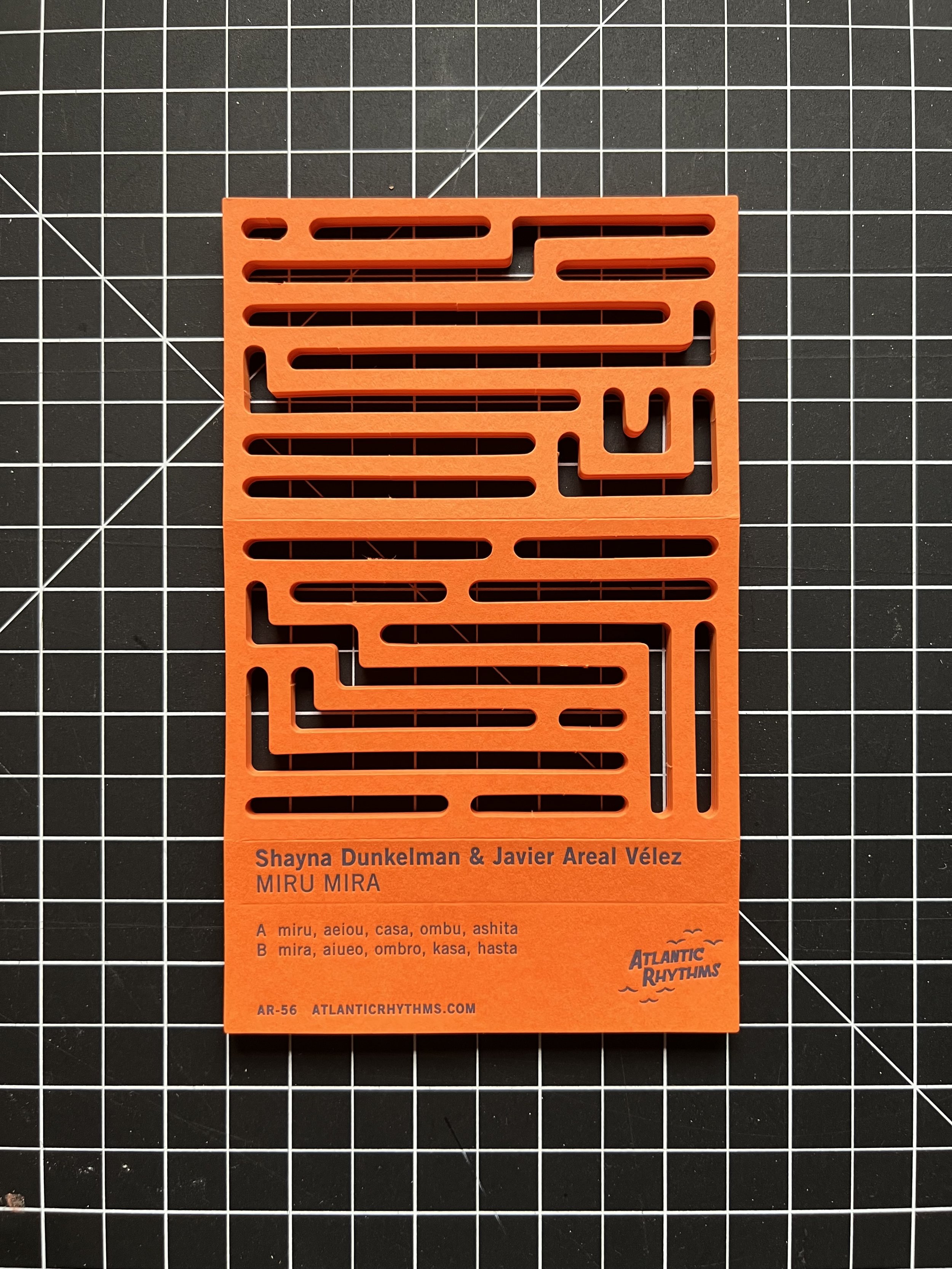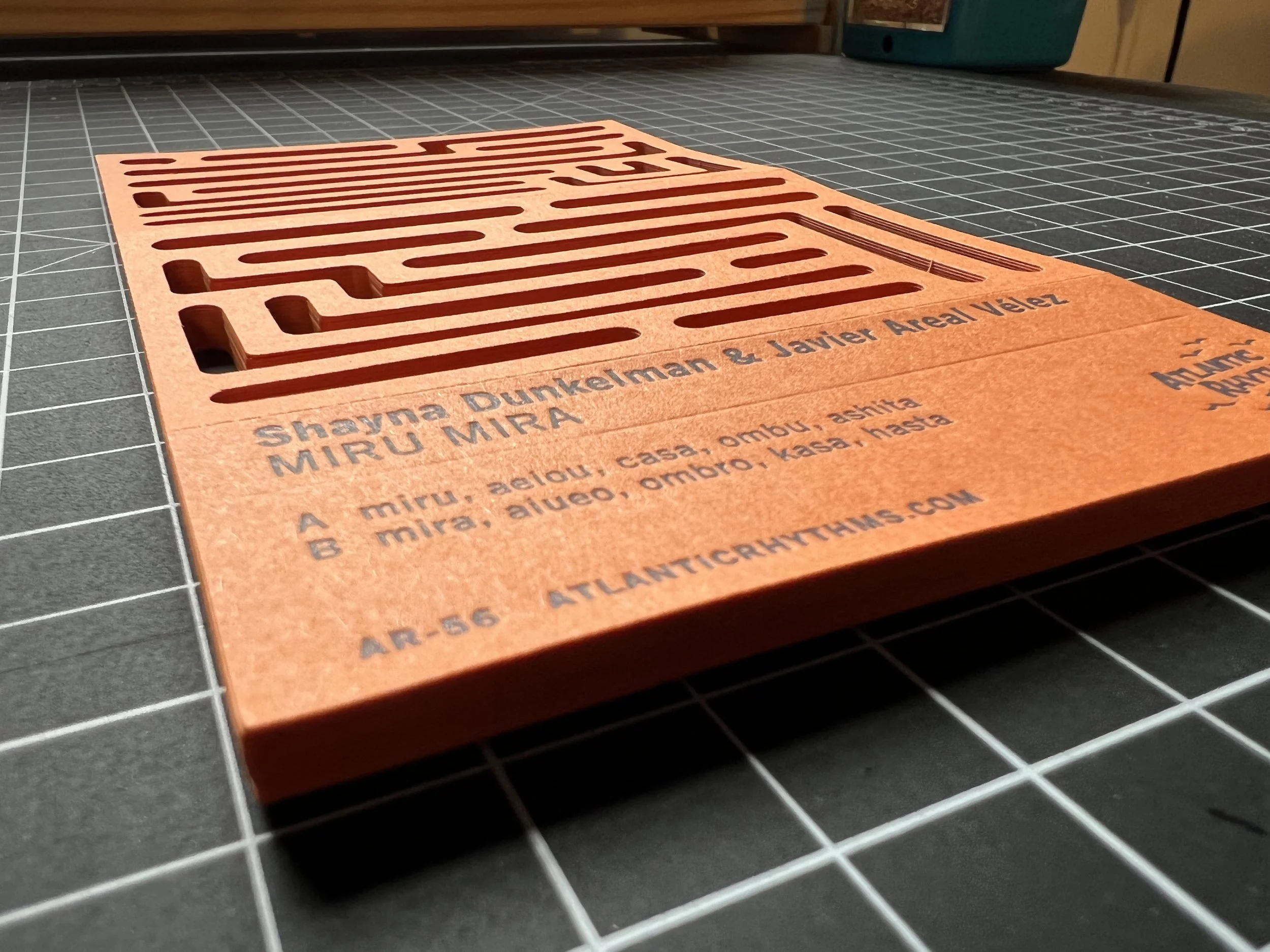SHAYNA DUNKELMAN & JAVIER AREAL VÉLEZ - MIRU MIRA
Photo of Shayna by Keisuke Tsujimoto. Photo of Alejandro Held.
SHAYNA DUNKELMAN & JAVIER AREAL VÉLEZ
MIRU MIRA
AR-56
The album's title, 'Miru Mira,' means "to see" in Japanese and Spanish consecutively. Senses play a significant role in this daring collaboration between percussionist Shayna Dunkelman and composer Javier Areal Vélez. Combining a playful exploration of the senses with phonological connections between Spanish and Japanese languages, Miru Mira takes inspiration and finds connection through linguistics and sound.
Miru Mira’s phonological song title convention connects to the aural resonance of the live and organic sound captured in the studio. “Both Shayna and I tend to play quite loud,” according to Javier, “so it was a very warm session, keeping the intense energy of a gig almost.”
Release Date: February 10, 2023
No Plan Press designed these letterpressed j-cards that feature a die cut pattern that plays with the interplay of the paper and cassette as well as overlapping folds, revealing tiny shadows. The cut-outs create a depth and interaction with the tape itself while the letterpress design adds texture and tactility.
Interview w/ Shayna & Javier
How did the Miru Mira project begin?
Javier: I toured NYC in January 2020, Shayna I talked about collaborating for the first time ever, so we did a duo improv gig at a super small cozy venue. Shayna played modular synth, bells and objects, and I played the prepared electric guitar. We hit it off quite instantly.
Shayna: After the show, we quickly scheduled a recording session at Javier’s friends studio, which was in the same building AND the same floor as my percussion studio at the time. This definitely helped feel like something good was in the making.
How did you both meet and decide to collaborate?
J: Shayna and I actually met in a quite bizarre NYC gig back in 2012(?). It was an improv concert that ended up with an open jam in which we may or may not have played together. I just remember a crowd screaming trying to get Chris Pitsiokos to play a sexy sax solo; which sadly we could not get him to do.
S: My lady friends were pretty aggressive with the chanting, haha. How would I ever forget that.
J: Afterwards, we met again in Argentina in 2017, when I organized the visit of Shayna's band at the time (Xiu Xiu) to perform at RUIDO, an experimental music series I curated.
Were there any influences discussed at the beginning of this project?
J: I don't recall much talk about influences. We both knew each of our personal paths as improvisers and trusted that we'd be able to figure out the music on the spot without much discussion.
At the time of recording, we did plan some loose-form ideas.
We were both interested in exploring short-ish pieces instead of recording a long free-form improv thing. We also wanted Shayna to overdub electronics afterward, so we played the drums and guitar duo live, but bringing this idea of leaving free space from time to time.
S: Improvising and creating music with someone for the first time is always slightly awkward, since you don’t know the other person’s musical language. However, this collaboration felt natural because we agreed on what kind of improvisational approach we wanted to utilize to maintain a theme that connected each piece.
What have you learned from each other, or how have you grown from working together?
S: I’m quite selective when it comes to people who I’d want to improvise with, because sometimes….they can end up sounding…(let’s just say) random.
However, I was really quite pleased with the result. We used improvisation as a tool for composition but worked carefully on the edits and overdubs. I think that extra care makes a difference.
Where did you record your music? Did this location impact the output?
J: Actually, the recording came along quite quickly and organically. Fran López, an artist/musician/engineer friend from Argentina who lives in NYC, attended our only gig in Brooklyn and offered to record us right away.
A few days later, we went to a studio where he was working. He had some quite special ideas about how to set up the guitar and the drums in space. You know, many times the engineer tries to physically isolate the instruments the most, so you can then mix them with some sort of independence. However many times this can be tricky in practice since the sound bleeds from one instrument to the other and you end up with a weird presence of both instruments in all of the mics!
After we decided we'd mix the record quite mono (guitar and drums centered), Fran proposed we put the guitar amp opposite to the drum set, facing directly to it. This way, the amp will definitely bleed into all of the drums mics, but in a balanced way; and also the guitar sound will resonate in the drumset itself. This gave a very live and organic sound to the result, and also meant we could play really live, without headphones. Both Shayna and I tend to play quite loud so it was a very warm session, keeping the intense energy of a gig almost.
How did you feel when it was complete? How did you know when it was finished?
J: We recorded for a few hours until we felt we had a nice amount of varied material. Then I returned to Argentina, and over the distance, we spent several months listening to the recording, choosing the tracks, and setting up the order. We both share a real interest for finding the right balance of the type of sounds that each track holds and we also think the track order can make or break a record, so it was nice to go through the process with these shared ideas in mind.
Are there any visual styles that you identify with, or incorporate into your art? Do you honor them or subvert them in some way?
S: I’m really into Japanese supernatural ghosts/demons(??) Called Yokai. The inspiration for the artwork came from that. At least that is the photos we sent in. I don’t want to take credit for the beautiful design that I didn’t do.
J: We also tried to find odd connections between our heritages. We looked for words that had close meanings or which sounded similar in Japanese and Spanish and used those while naming the tracks and album.
Where does this work fit in with other work you’ve created?
S: Anything and everything. Friendship, collaboration, coincidence and curiosity is always in my work.
Does it continue your previous work? Is it an evolution or a departure?
S: This is our first time collaborating, but I hope to explore more opportunities.




